Timeline: Reforms in Myanmar
- Published
A process of reform has been under way in Myanmar (also known as Burma) since November 2010, when military rule was replaced by a new military-backed civilian government. Here is a timeline of key developments.
2010

Aung San Suu Kyi was released from house arrest in November 2010
November: The main military-backed party, the Union Solidarity and Development Party (USDP), claims a resounding victory in the first elections for 20 years. Opposition groups allege widespread fraud and many Western countries condemn the vote as a sham. The junta says it marks the transition from military rule to a civilian democracy.
A week after the election, Aung San Suu Kyi - who had been prevented from taking part - is released from house arrest.
2011
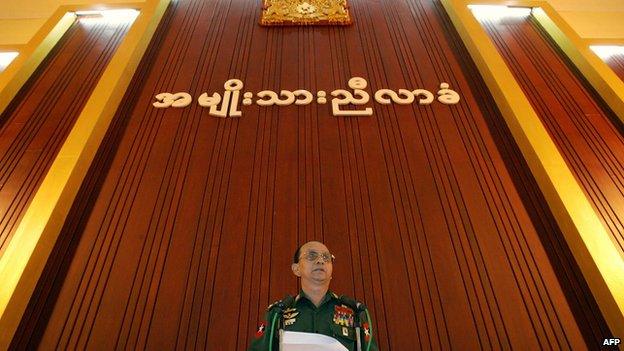
Thein Sein was sworn in on 30 March 2011 alongside two vice presidents and the newly-elected parliament
January: The government authorises internet access for Aung San Suu Kyi.
March: Thein Sein is sworn in as president of a nominally civilian government and the transfer of powers to the new government is complete.
May: The new government frees thousands of prisoners under an amnesty, but few political prisoners are among them and the move is dismissed by one rights group as "pathetic".
August: Aung San Suu Kyi is allowed to leave Rangoon on a political visit; days later she meets President Thein Sein in Nay Pyi Taw.
September: President Thein Sein suspends construction of controversial Chinese-funded Myitsone hydroelectric dam, in move seen as showing greater openness to public opinion.
October: More than 200 political prisoners are freed as part of a general amnesty. New labour laws allowing unions are passed.
November: The Association of Southeast Asian Nations (Asean) agrees that Burma will chair the grouping in 2014. Aung San Suu Kyi says she will stand for election to parliament, as her party rejoins the political process.
December: US Secretary of State Hillary Clinton visits, meets Ms Aung San Suu Kyi and holds talks with President Thein Sein. The US offers to improve relations if democratic reforms continue.
President Thein Sein signs a law allowing peaceful demonstrations for the first time. The NLD re-registers as a political party in advance of by-elections for parliament due to be held early in 2012.
Burmese authorities agree a truce with rebels of the Shan ethnic group and order the military to stop operations against ethnic Kachin rebels.
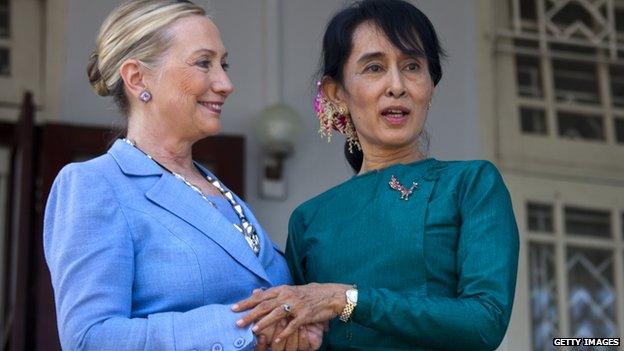
US Secretary of State Hilary Clinton met Ms Suu Kyi in December 2011
2012
January: The government signs a ceasefire with rebels of Karen ethnic group.
A day later, hundreds of prisoners are released - among them the country's most prominent political prisoners, including veterans of the 1988 student protest movement, monks involved in the 2007 demonstrations and activists from many ethnic minority groups.
April: Taking part in an election for the first time since 1990, the NLD wins 43 out of 45 seats in landmark parliamentary by-elections seen as a major test for Myanmar's reform drive. The polls are thought to have been generally free and fair.
The US responds by easing sanctions on Myanmar. The EU also agrees to suspend most sanctions in Myanmar and opens an office in the biggest city, Rangoon.
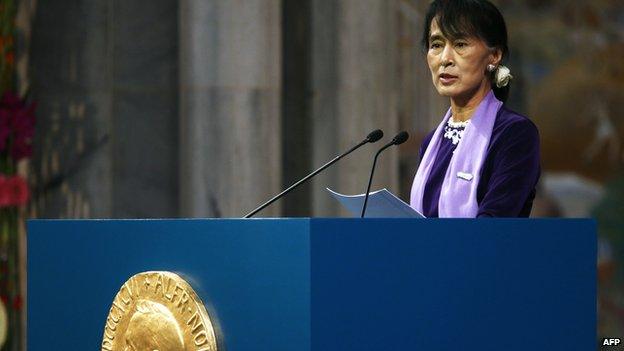
Aung San Suu Kyi delivers her Nobel acceptance speech in Oslo on 16 June, 2012
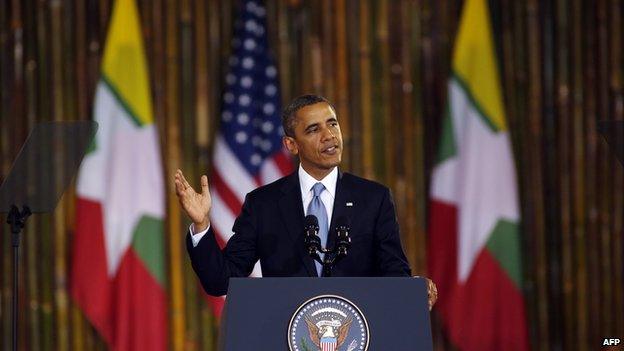
In November 2012, Mr Obama made the first visit by a US president to Myanmar
June: Aung San Suu Kyi visits Norway to collect the Nobel Peace Prize she was awarded in 1991, before travelling on to the UK to meet old friends, family and to address parliament.
Meanwhile, communal violence erupts in Rakhine state between Buddhists and Muslims, leaving some 80,000 people displaced.
July: Aung San Suu Kyi makes her parliamentary debut, one of 43 members of the National League for Democracy (NLD) to have secured a seat.
August: Myanmar removes 2,082 names from its blacklist which bars people deemed a threat to national security from entering or leaving the country.
September: President Thein Sein visits the US, shortly after Aung San Suu Kyi also tours the country - she collects a Congressional Medal of Honour.
October: Violence flares again in Rakhine, as aid agencies warn of a worsening humanitarian crisis.
November: US President Barack Obama visits Myanmar on the first such visit by a US leader.
December: The government announces that privately owned newspapers are to be allowed in Myanmar from April 2013 for the first time in almost 50 years.
Myanmar ushers in the new year for the first time with a public countdown.
2013
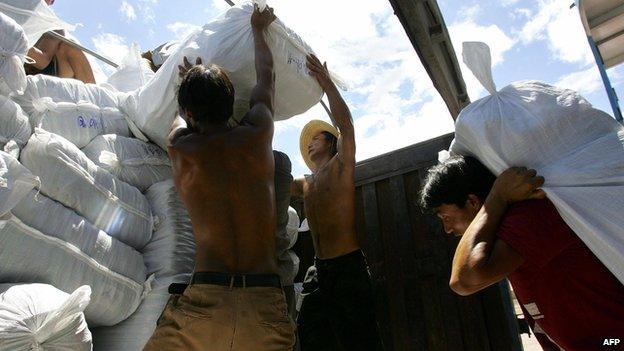
The Asian Development Bank resumed loans to Myanmar to boost its social and economic development
January: The government abolishes a 25-year-old ban on public gatherings of more than five people.
The Asian Development Bank resumes loans to Myanmar for the first time in 30 years in an attempt to boost its social and economic development.
February: The government and ethnic Kachin rebels reach an agreement to hold talks, after weeks of fighting in the north-east of the country.
A report reveals that police fired military-issue white phosphorus grenades to disperse protesters at the controversial Monywa copper mine.
Thein Sein embarks on his first European tour as head of state.
March: A dispute involving three Muslims in the central Burmese town of Meiktila triggers deadly clashes between Muslim and Buddhist communities.
More than 40 people die in clashes and around 12,000 Muslims are displaced from their homes. A state of emergency is declared in the area.
Thein Sein warns the government will use force to stop "political opportunists and religious extremists" from fomenting hatred between faiths.
April: The European Union lifts its remaining trade, economic and individual sanctions - except those on arms sales - in response to Myanmar's political reform programme.
Human rights groups criticise the move as premature, saying it reduces the leverage the EU has on Myanmar.
A report, external says there is clear evidence of government complicity in ethnic cleansing and crimes against humanity against Muslims in Rakhine state. The government rejects the allegations.
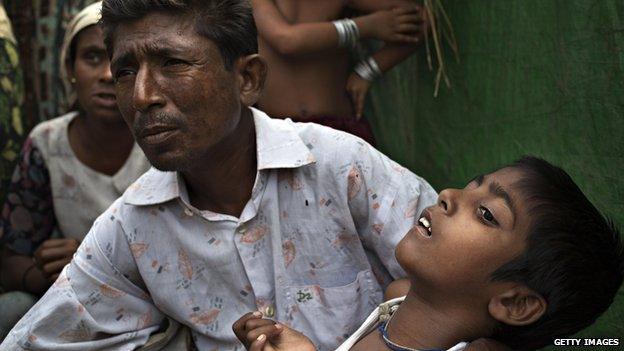
A Rohingya father holds his son who he says was hit by stones during violence in Rakhine state
2014
January: Myanmar finalises a landmark agreement to open its telecoms network opened up to foreign investment.
May: US extends some sanctions for another year, saying that despite the recent reforms, rights abuses and army influence on politics and the economy persist.
October: The Myanmar government announces it is releasing more than 3,000 prisoners including former military intelligence officers reputed to have been close to former Prime Minister Khin Nyunt.

President Thein Sein welcomes US President Barack Obama
November: Aung San Suu Kyi says reforms in the country have "stalled".
US President Barack Obama visits the country and says he is "optimistic" about the political transition.
2015
January: The government agrees to hold talks with students after a rare protest march in Mandalay over a new education bill which they say curbs academic freedom and increases central control. The BBC's Jonah Fisher remarks that five years ago the government would not have agreed to talks.
February: A state of emergency is declared in the Kokang region following intense fighting between ethnic-minority rebels and the army.
March: Student protests continue with hundreds being arrested around the country.
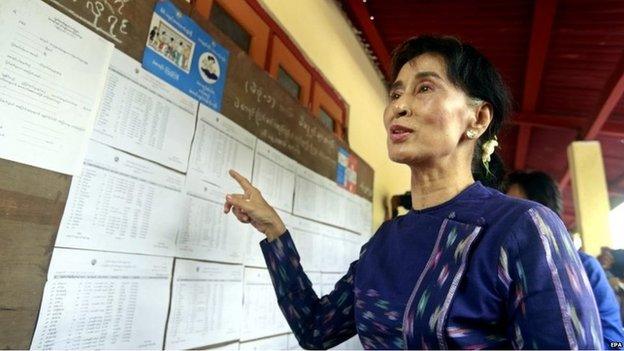
Aung San Suu Kyi checks the list of voters in a village in Yangon
April: Several newspapers print black front pages to protest against the arrest and jailing of journalists in Myanmar, which has a history of heavy censorship.
June: Parliament votes to keep the army's veto over constitutional change, dealing a blow to hopes for fuller democracy.
July: The date for the first open general election with the potential widest participation of opposition parties is set for 8 November.